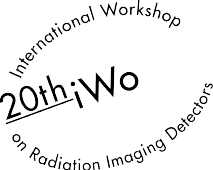Speaker
Description
The Compton camera concept is based on reconstruction of recorded Compton scattering events of incoming gamma rays. The scattering of primary gamma ray occurs in the first detector (called scattering detector – usually thin) recording position and energy of recoiled electron. The scattered gamma quantum continues towards the second detector (called absorption detector - usually thick) where it is absorbed. The second detector records the energy and position of this scattered gamma. Using Compton scattering equation it is possible to determine the scattering angle and estimate possible directions of the original gamma ray as a surface of the cone. When the Compton camera records number of such events the location and shape of the gamma source can be reconstructed.
Timepix3, a hybrid single photon counting pixel detector, is perfect device for creation of a compact Compton camera. Timepix3 is an event based readout chip (every hit pixel is immediately sent to a readout) and can record time-of-arrival (ToA) and energy of incident gamma simultaneously in each pixel. The chip offers high energy resolution (1 keV at 60 keV, 7 keV at 356 keV) as well as time resolution (1.6ns). The Timepix3 readout chip can be combined with different sensor materials (Si, CdTe, CZT).
In this contribution we present a very compact detector system for imaging with gamma-rays using Compton camera principle. The system consists of at least two layers of hybrid pixel detectors Timepix3 with sensors optimized for gamma-ray tracking. The front detector layers (scattering) are made of silicon of various thickness (up to 1 mm) while the last layers (absorbing) are equipped with thick CdTe or CZT sensors up to 2 mm in thickness. The total absorption of the whole detector can be very high if several CdTe or CZT layers are used. The maximal number of layers is not limited but the practical evaluation was performed with 2 layers. Thanks to Timepix3 simultaneous measurement of ToA and energy it is possible to precisely detect coincidence events in the detector layers. Based on the energy and position of these events it is possible to estimate the possible direction of the original gamma. The angular resolution of the presented Compton camera depends on the detected energy and reaches units of degrees.




